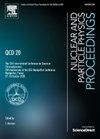(Q¯q
Q4 Physics and Astronomy
Nuclear and Particle Physics Proceedings
Pub Date : 2024-04-01
DOI:10.1016/j.nuclphysbps.2023.11.008
引用次数: 0
摘要
我们回顾了最近关于重轻奇异态的研究工作,其中包括微扰 QCD 最低阶(LO)谱函数的新的紧凑综合表达式,以及算子乘积展开(OPE)的高达 d=6 的凝聚态。包括高阶(HO)PT 修正(我们通过假设分子/四夸克谱函数的因子化来估计),我们用拉普拉斯和规则(LSR)和有限能量(FESR)QCD 谱和规则(QSSR)方法评估了质量和耦合。我们总结了基于稳定性标准的最优结果,并与实验候选结果和一些 LO QSSR 结果进行了比较。我们的结论是,我们预测的光谱并不能证实 X(5568) 是一个纯分子或四夸克态。XZ观测态的质量与(几乎)纯JPC=1+±,0++分子或/和四夸克态相容。介子质量的 SU3 修正很小:对于 c(分别为 b)夸克通道来说≤10%(分别为≤3%),但对于耦合来说可能很大(≤20%)。我们预计,D-K+阈值附近的共振可能来自于 0+(D-K+)分子和/或 D-K+ 散射。X0(2900)、XJ(3150)(如果 J = 0)、X1(2900)和 XJ(3350)(如果 J = 1)可能来自四分子之间的最小混合模型和第一次径向激发。Zc(3900,4025,4040,4430) 和 Zcs(3983) 光谱可以很好地由分子和四分子候选者或径向激发重现。 本文章由计算机程序翻译,如有差异,请以英文原文为准。
(Q¯q¯Qq) from QCD Laplace sum rule
We present a review of our recent works on heavy-light exotic states, with new compact integrated expressions of the spectral functions at lowest order (LO) of perturbative (PT) QCD and up to condensates of the Operator Product Expansion (OPE). Including higher order (HO) PT corrections, which we have estimated by assuming the factorization of the molecule/four-quark spectral functions, we evaluate masses and couplings with the Laplace sum rules (LSR) and finite energy (FESR) QCD spectral sum rules (QSSR) approaches. Our optimal results based on stability criteria are summarized and compared with experimental candidates and some LO QSSR results. We conclude that, our predicted spectra, do not confirm that the is a pure molecule or a four-quark state. The masses of the XZ observed states are compatible with (almost) pure molecule or/and four-quark states. The SU3 corrections on the meson masses are tiny: (respectively ) for the c (respectively b)-quark channel but can be large for the couplings (). We expect that the resonance near the threshold can be originated from the molecule and/or scattering. The , (if J = 0), and the (if J = 1) can emerge from a minimal mixing model between tetramoles and first radial excitation. The and spectra are well reproduced by the molecules and tetramoles candidates, or radial excitation.
摘要
我们回顾了最近关于重轻奇异态的研究工作,其中包括微扰 QCD 最低阶(LO)谱函数的新的紧凑综合表达式,以及算子乘积展开(OPE)的高达 d=6 的凝聚态。包括高阶(HO)PT 修正(我们通过假设分子/四夸克谱函数的因子化来估计),我们用拉普拉斯和规则(LSR)和有限能量(FESR)QCD 谱和规则(QSSR)方法评估了质量和耦合。我们总结了基于稳定性标准的最优结果,并与实验候选结果和一些 LO QSSR 结果进行了比较。我们的结论是,我们预测的光谱并不能证实 X(5568) 是一个纯分子或四夸克态。XZ观测态的质量与(几乎)纯JPC=1+±,0++分子或/和四夸克态相容。介子质量的 SU3 修正很小:对于 c(分别为 b)夸克通道来说≤10%(分别为≤3%),但对于耦合来说可能很大(≤20%)。我们预计,D-K+阈值附近的共振可能来自于 0+(D-K+)分子和/或 D-K+ 散射。X0(2900)、XJ(3150)(如果 J = 0)、X1(2900)和 XJ(3350)(如果 J = 1)可能来自四分子之间的最小混合模型和第一次径向激发。Zc(3900,4025,4040,4430) 和 Zcs(3983) 光谱可以很好地由分子和四分子候选者或径向激发重现。We present a review of our recent works on heavy-light exotic states, with new compact integrated expressions of the spectral functions at lowest order (LO) of perturbative (PT) QCD and up to condensates of the Operator Product Expansion (OPE). Including higher order (HO) PT corrections, which we have estimated by assuming the factorization of the molecule/four-quark spectral functions, we evaluate masses and couplings with the Laplace sum rules (LSR) and finite energy (FESR) QCD spectral sum rules (QSSR) approaches. Our optimal results based on stability criteria are summarized and compared with experimental candidates and some LO QSSR results. We conclude that, our predicted spectra, do not confirm that the is a pure molecule or a four-quark state. The masses of the XZ observed states are compatible with (almost) pure molecule or/and four-quark states. The SU3 corrections on the meson masses are tiny: (respectively ) for the c (respectively b)-quark channel but can be large for the couplings (). We expect that the resonance near the threshold can be originated from the molecule and/or scattering. The , (if J = 0), and the (if J = 1) can emerge from a minimal mixing model between tetramoles and first radial excitation. The and spectra are well reproduced by the molecules and tetramoles candidates, or radial excitation.

 求助内容:
求助内容: 应助结果提醒方式:
应助结果提醒方式:


